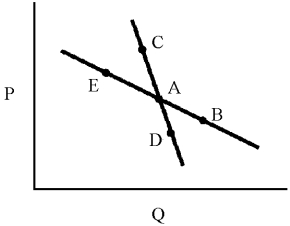A) consideration of rivals' reactions.
B) standardized products.
C) high profits.
D) unused capacity.
Correct Answer

verified
Correct Answer
verified
Multiple Choice
Which of the following conditions distinguishes monopolistic competition from perfect competition?
A) number of sellers
B) freedom of entry and exit
C) perfect information
D) homogeneity of the product
Correct Answer

verified
Correct Answer
verified
True/False
Price leadership works only if there is a single, dominant firm in the oligopoly.
Correct Answer

verified
Correct Answer
verified
Multiple Choice
According to the kinked demand curve model, an oligopolist may face
A) more elastic demand than a monopolistic competitor.
B) less elastic demand than a monopolistic competitor.
C) more elastic demand if she raises her price than if she lowers her price.
D) less elastic demand if she raises her price than if she lowers her price.
Correct Answer

verified
Correct Answer
verified
Multiple Choice
The excess capacity theorem implies that
A) consumers would be better off if some monopolistically competitive firms left their markets.
B) consumers would be better off with more standardization of products.
C) monopolistic competition benefits society by eliminating excess capacity in production.
D) monopolistic competition wastes some of society's resources but the elimination of this waste does not necessarily benefit consumers.
Correct Answer

verified
Correct Answer
verified
Multiple Choice
Oligopoly occurs when
A) a few firms sell many different products.
B) a few firms sell to a few large buyers.
C) many firms dominate a single market.
D) a few firms dominate a single market.
Correct Answer

verified
Correct Answer
verified
True/False
A cartel is a group of sellers of a single product who have joined together in order to enjoy the advantages of perfect competition.
Correct Answer

verified
Correct Answer
verified
Multiple Choice
Figure 12-3
 -Oligopolist A cuts price in an attempt to enlarge his share of the market.His competitors fail to retaliate with price cuts.In this case, in Figure 12-3, oligopolist A will move from point A to which point?
-Oligopolist A cuts price in an attempt to enlarge his share of the market.His competitors fail to retaliate with price cuts.In this case, in Figure 12-3, oligopolist A will move from point A to which point?
A) B
B) C
C) D
D) E
Correct Answer

verified
Correct Answer
verified
Multiple Choice
Identify the market structure characterized by many small firms selling somewhat different products.
A) Monopoly
B) Monopolistic competition
C) Perfect competition
D) Duopoly
Correct Answer

verified
Correct Answer
verified
True/False
Society definitely benefits by reducing the number of monopolistically competitive firms.
Correct Answer

verified
Correct Answer
verified
Multiple Choice
Which of the following is not a requirement for the existence of monopolistic competition in a market?
A) numerous small sellers
B) full information about the market among buyers and sellers
C) product homogeneity
D) freedom of entry into the market
Correct Answer

verified
Correct Answer
verified
Multiple Choice
A monopolistically competitive firm
A) tries to differentiate its product from competitors' products.
B) faces a perfectly elastic demand curve for its product.
C) has more monopoly power in the long run than does a perfectly competitive firm.
D) is always a retail establishment.
Correct Answer

verified
Correct Answer
verified
Multiple Choice
Firms have the option of maximizing sales revenue or maximizing profits.If a firm chooses to maximize sales, then it will produce
A) more output and charge a lower price.
B) the same output and charge a lower price.
C) less output and charge a higher price.
D) less output and charge a lower price.
Correct Answer

verified
Correct Answer
verified
Multiple Choice
A firm in a monopolistically competitive market makes no economic profit in the long run because
A) long-run marginal cost will be too high to make any economic profit.
B) long-run price will be equal to long run marginal cost.
C) long-run marginal cost will be equal to long run marginal revenue.
D) long-run price will be equal to long run average cost.
Correct Answer

verified
Correct Answer
verified
Multiple Choice
A firm now produces its sales-maximizing level of output.If the firm increased its output by one unit, its marginal revenue would become
A) negative.
B) smaller but still positive.
C) larger but still negative.
D) larger but still positive.
Correct Answer

verified
Correct Answer
verified
True/False
Monopolistically competitive firms can earn large profits in the long run.
Correct Answer

verified
Correct Answer
verified
Multiple Choice
A monopolistically competitive firm in the long run will
A) have a demand curve tangent to its AC.
B) have a demand curve below its AC.
C) have a demand curve above its AC.
D) operate where excessive profit can be achieved.
Correct Answer

verified
Correct Answer
verified
Multiple Choice
A perfectly competitive firm and a monopolistically competitive firm are similar in each of the following respects except
A) each has many buyers and sellers.
B) firms sell homogeneous products in both markets.
C) in having perfect information.
D) for freedom of exit and entry.
Correct Answer

verified
Correct Answer
verified
True/False
One of the most famous cartels is OPEC.
Correct Answer

verified
Correct Answer
verified
True/False
Monopolistically competitive markets feature high barriers to entry.
Correct Answer

verified
Correct Answer
verified
Showing 61 - 80 of 225
Related Exams